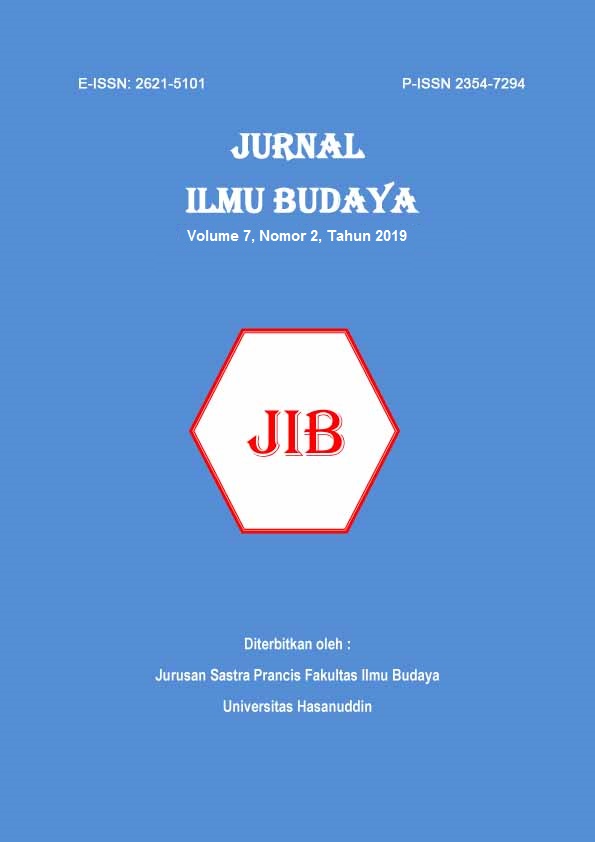RITUAL POSUO ‘PINGITAN’ PADA MASYARAKAT SUKU BUTON: KAJIAN SEMIOTIKA
DOI:
https://doi.org/10.34050/jib.v7i2.7952Keywords:
Ritual of Posuo, Symbols, Semiotics of Roland Barthes.Abstract
This study aims to explain the stages of implementation of posuo ritual, analyze the meaning of denotation and conotation of the symbols and myths found in posuo ritual. The type of research used in this study is a qualitative description. Data collection techniques used are observation, interviews, records, and documentation. In analyzing the data it was used Roland Barthes semiotics analysis. The researchwas conducted in Wawoangi village, Sampolawa District, South of Buton regency. The results show that the stages of the implementation of the posuo ritual consist of 3, namely 1) preparation, 2) implementation which include pokunde (shampoo), pebaho (bathing), pauncura (inauguration), panimpa (blessing), padole (laid down), palego (moving limbs), pasipo (disapapi), posuo (confinement), bhaliana yimpo (change in sleeping position), matana posuo (peak of the event), and 3) closing. The symbols contained in the posuo ritual are divided into two. First, symbols in the form of implementation procedures including: pokunde, pebaho, panimpa. Seconf, symbols in the form of object/equipment including: suo (back room of the house), ndamu (ax), shroud/white cloth, and patirangga (nail dye leaves). In general, these symbols contain the meaning of purity, beauty, safety, strength, and direction of mate. Buton people believe in the posuo ritual as means to test the purity of the girls and the means to find out the direction of their soul mate. In adition, people also believe that by following the posuo ritual, a girl like bein reborn in a clean and pure state, lools more beautiful and charming, will get a good match and also a good life, especially in running on a households life.
References
Barthes, Roland. 1968. Elements of Semiology. New York: Hill and Wang.
Berger, A. Asa. 2010. Pengantar Semiotika:Tanda-tanda dalam Kebudayaan Kontemporer, Edisi Terbaru. Yogyakarta: Tiara Wacana.
Danandjaja, James. 2007. Folklor Indonesia:Ilmu Gosip, Dongeng, dan lain-lain. Jakarta: Pustaka Utama Grafiti.
Departemen Pendidikan dan Kebudayaan . 1985. Kamus Wolio-Indonesia. Jakarta: Pusat Pembinaan dan Pengembangan Bahasa.
Fariki, La. 2009. Mengapa Perempuan Buton dan Muna Dipingit? Kendari: Komunika.
Fiske, John. 1990. Cultural and Communication Studies: Sebuah Pengantar Paling Komprehensif. Yogyakarta : Jalasutra.
Hasyim, Muhammad. 2014. Konstruksi Mitos dan Ideologi dalam Teks Iklan Komersial Televisi, Suatu Analisis Semiologi. Disertasi Program Studi Linguistik, Universitas Hasanuddin Makassar.
Kusuma, S. Zaimar. 2013. Semiotika dalam Analisis Karya Sastra. Depok: PT. Komodo Books.
Sadulloh. 2004. Pengantar Filsafat Pendidikan. Bandung: Alfabeta.
Sobur, Alex. 2004. Analisis Teks Media. Bandung : PT. Remaja Rosdakarya.
________. 2009. Semiotika Komunikasi. Bandung: PT. Remaja Rosdakarya.
Zoest, Aart van. 1993. Semiotika: Tentang Tanda, Cara Kerjanya, dan, Apa yang Kita Lakukan Dengannya. Ani Soekawati (Penerj.). Jakarta: Yayasan Sumber Agung.
Downloads
Published
Issue
Section
License
Copyright (c) 2019 JURNAL ILMU BUDAYA

This work is licensed under a Creative Commons Attribution-NonCommercial 4.0 International License.


